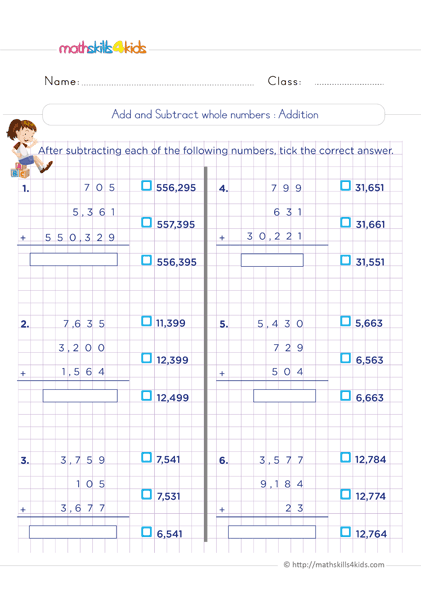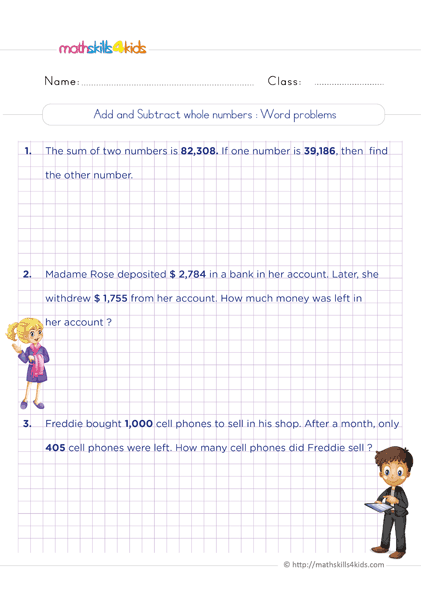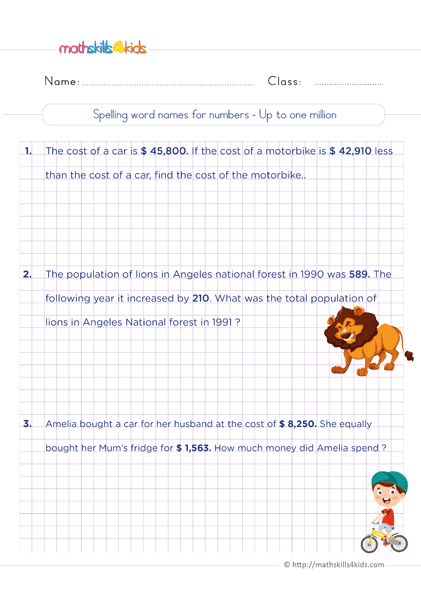Grade 6 whole number worksheets: Roman numerals, Place Value, Spelling, Add & Subtract
Hello math lovers! This article is prepared to sharpen 6th graders' skills in whole numbers mastery in a unique way. We have selected some fantastic Grade 6 whole number worksheets from Mathskills4kids.com covering topics like Roman numerals, Place Value, Spelling, Add & Subtract, etc.
The different components of the Grade 6 whole number worksheets you’ll find in this article include:
-
- Understanding Roman numerals
- Mastering place value in whole numbers
- Spelling rules for Grade 6 whole number worksheets
- Addition strategies for Grade 6 whole number worksheets
- Subtraction techniques for Grade 6 whole number worksheets
- Common challenges and misconceptions in Grade 6 whole number worksheets
- Tips for effectively practicing Grade 6 whole number worksheets
- Additional resources for Grade 6 whole number worksheets
- Conclusion: Unleash your potential with Grade 6 whole number worksheets
Demystifying Grade 6 whole number worksheets: Unleash your potential with Roman numerals, place value, spelling, addition, and subtraction
Welcome to the world of demystifying Grade 6 Whole Number Worksheets, where the mysteries of Roman numerals, place value, spelling, addition, and subtraction are unraveled to unleash your full potential. Whether you're a student looking to conquer these fundamental concepts or a teacher seeking engaging resources to captivate your students' attention, you've come to the right place. This article aims at
In this comprehensive guide, we'll break down the complexities of Roman numerals, delve into the depths of place value, master the art of spelling, and explore the intricacies of addition and subtraction. With our carefully crafted worksheets and expert guidance, your 6th Grade students will understand these topics profoundly and develop the skills and confidence needed to excel in mathematics.
Get ready to embark on an exciting journey of learning and discovery as we demystify Grade 6 Whole Number Worksheets together. Let's dive in and unlock your mathematical prowess!
-
BROWSE THE WEBSITE
-
DOWNLOAD FREE WORKSHEETS
-
-
GRADE 6 MATH TOPICS
- Whole numbers
- Multiplication
- Division
- Exponents and square roots
- Number theory
- Decimals
- Add & subtract decimals
- Multiply & divide decimals
- Fractions & mixed numbers
- Add & subtract fractions
- Multiply fractions
- Divide fractions
- Integers
- Operations with integers
- Mixed operations
- Rational numbers
- Problems solving
- Ratio & proportions
- Percentages
- Measuring units
- Money math
- Consumer math
- Telling time
- Coordinate graph
- Algebraic expressions
- One step equations
- Solve & graph inequalities
- Two-step equations
- 2D Geometry
- Symmetry & transformation
- 3D Shapes
- Geometry measurement
- Data and Graphs
- Statistics
- Probability
-
-
The place value of digits in whole numbers
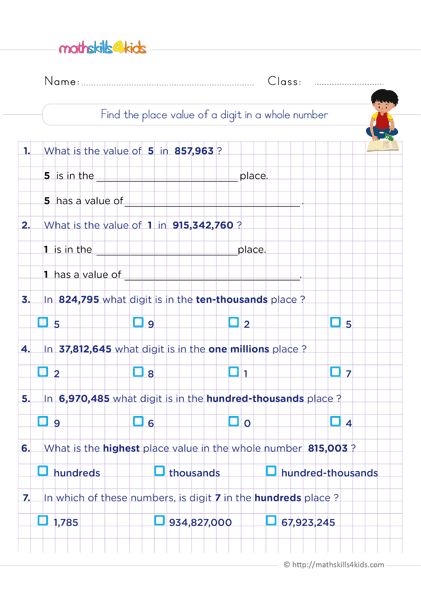 Print it...
Print it...
-
How to write numbers in figures and words
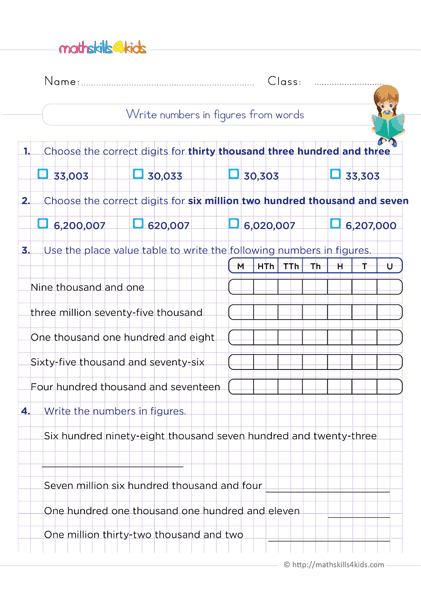 Print it...
Print it...
-
Spelling numbers in words up to one million
 Print it...
Print it...
-
Writing numbers in words up to millions
 Print it...
Print it...
-
One to thousands standard numbers to Roman numerals writing
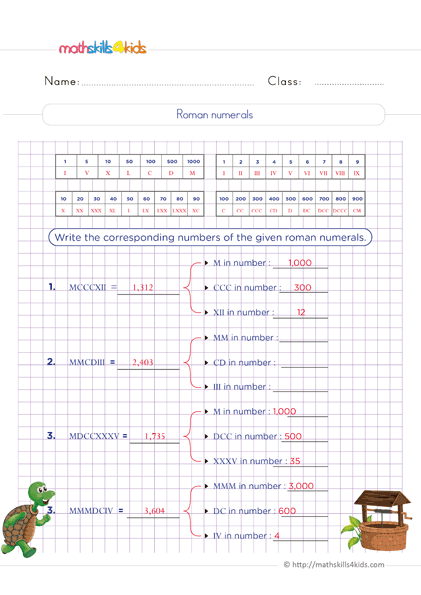 Print it...
Print it...
-
Standard numbers to Roman numerals matching
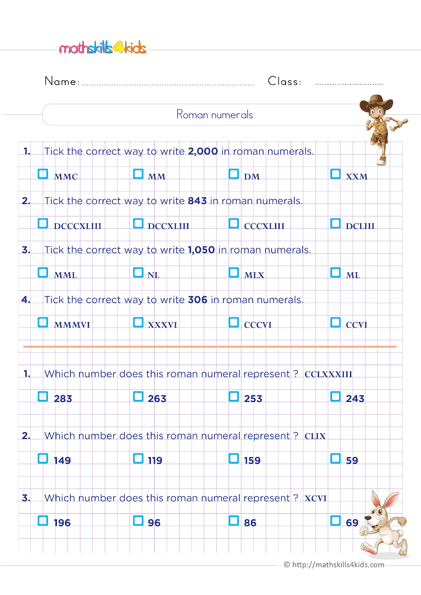 Print it...
Print it...
-
The place value of digits in whole numbers
-
Buying is supporting us!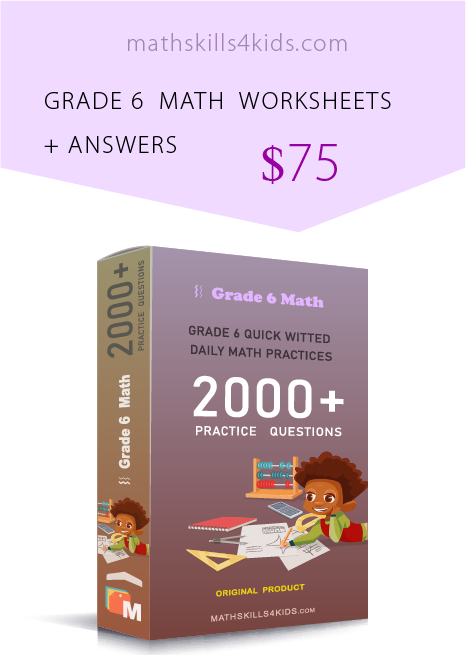
Buy Now...
-
-
Understanding Roman numerals
Understanding Roman numerals enhances students’ number sense skills and lets them realize that numbers can look different in several forms and remain equal.
Roman numerals are a system of writing numbers that use letters instead of digits. For example, the number 14 is written as XIV in Roman numerals. Roman numerals often represent dates, centuries, chapters, or ordinal numbers.
To read and write Roman numerals, we need to know the values of the letters and how they are combined. Here are the basic rules:
- The letters I, V, X, L, C, D, and M represent the values 1, 5, 10, 50, 100, 500, and 1000 respectively.
- If a smaller value is placed before a larger one, it is subtracted from the larger one. For example, IV means 4 (5 - 1), and IX means 9 (10 - 1).
- If a smaller value is placed after a larger one, it is added to the larger one. For example, VI means 6 (5 + 1), and XI means 11 (10 + 1).
- We can repeat a letter up to three times in a row to add its value. For example, III means 3 (1 + 1 + 1) and XXX means 30 (10 + 10 + 10).
- We cannot repeat a letter more than three times in a row. To write larger numbers, we need to use different combinations of letters. For example, to write 40, you cannot use XXXX, but you can use XL (50 - 10).
To practice reading and writing Roman numerals with your learners, you can use this online converter: https://www.rapidtables.com/convert/number/roman-numerals-converter.html.
-
Mastering place value in whole numbers
Before mastering place value in whole numbers, let’s determine what it means. Place value is the value of each digit in a number based on its position. For example, in the number 3572, digit 3 has a place value of 1000, digit 5 has a place value of 500, digit 7 has a place value of 70, and digit 2 has a place value of 1.
Place value is essential in math because it helps us compare, order, round, and perform operations on whole numbers. To master place value in whole numbers, students need to know how to:
- Identify the place value of each digit in a number
- Write numbers in standard form (using digits), expanded form (using place values), and word form (using words)
- Compare and order numbers using symbols (<, >, =) or words (less than, greater than, equal to)
- Round numbers to the nearest ten, hundred, thousand, etc.
- Use place value charts and base-ten blocks to represent and manipulate numbers
-
Spelling rules for Grade 6 whole number worksheets
Spelling rules are the guidelines that help us spell words correctly. Spelling rules are fundamental when we write numbers in word form. Here are some spelling rules for Grade 6 whole number worksheets:
- Use hyphens (-) to connect two-digit numbers from twenty-one to ninety-nine
- Do not use hyphens for multiples of ten (twenty, thirty,...) or for hundred or thousand
- Use commas (,) to separate groups of three digits from right to left
- Use "and" to connect hundreds and tens, or ones
- Use ordinal numbers (first,...) when indicating position or order
- Capitalize ordinal numbers when they start a sentence or are part of a title
Here are some examples of spelling numbers correctly:
- The number 45 is spelled forty-five
- The number 100 is spelled one hundred
- The number 3572 is spelled three thousand five hundred seventy-two
- The number 2,496,381 is spelled two million four hundred ninety-six thousand three hundred eighty-one.
- The number 753rd is spelled seven hundred fifty-third
- The number 1st is spelled first
-
Sample of 5th-Grade Number Sense and Place Value Questions
To give you a better idea of the types of questions your child may encounter in 5th-grade math, here are some sample questions that assess number sense and place value skills:
- What is the place value of the digit 2 in 2,345?
- Round the number 6,732 to the nearest hundred.
- What is the value of the digit 8 in 8,765?
- Compare the numbers 4,589 and 4,895. Which number is greater? How do you know?
- What is the place value of the digit 1 in 1,234?
- Write the expanded form of the number 3,419.
- What is the place value of the digit 9 in 9,876?
These questions require students to apply their knowledge of number sense and place value to solve problems and make sense of numbers. Your child can develop fluency and confidence in these essential mathematical skills by practicing similar questions.
-
Addition strategies for Grade 6 whole number worksheets
Addition is the operation of combining two or more numbers to get a larger number. Addition is also called sum or total. To perform addition on whole numbers, it is essential to know how to:
- Align the numbers by their place values
- Add the digits in each place value from right to left
- Regroup or carry over if the sum of the digits is more than 9
- Write the final answer below the line
Here are some addition strategies for Grade 6 whole number worksheets:
- Use mental math to add small numbers quickly and accurately
- Use estimation to check the reasonableness of your answer
- Use properties of addition to simplify the calculation
- Use column addition to add large numbers vertically
- Use partial sums to add large numbers horizontally
Here are some examples of using addition strategies:
- To add 7 + 8, we can use mental math to recall that 7 + 7 = 14, so 7 + 8 = 14 + 1 = 15
- To add 426 + 698, we can use estimation and round each number to the nearest hundred: 426 ≈ 400 and 698 ≈ 700, so 426 + 698 ≈ 400 + 700 = 1100. Then compare our answer with the estimate and see if it makes sense.
- To add 426 + 698, we can use properties of addition and rearrange the numbers: 426 + 698 = (400 + 700) + (20 + 90) + (6 + 8) = 1100 + 110 + 14 = 1100. This way, we can add easier numbers first and then combine them.
- To add 426 + 698, we can use column addition and write the numbers vertically:

Then we can add the digits in each place value from right to left and regroup if necessary:

To add 426 + 698, we can use partial sums and write the numbers horizontally:
426 + 698 =
Then we can add each place value separately and write the partial sums below:
426 + 698 =
400 +700 = 1100
20 +90 =110
6 +8 =14
Finally, we can add the partial sums and write the final answer below:
426 + 698 =
400 +700 = 1100
20 +90 =110
6 +8 =14
1100 + 110 + 14 = 1224
-
Subtraction techniques for Grade 6 whole number worksheets
Subtraction is the inverse operation of addition. It means finding the difference between two numbers by taking away one number from another. For example, 8 - 3 = 5 means taking away 3 from 8 and getting 5 as the difference.
There are different techniques for subtracting whole numbers, depending on the size and complexity of the numbers involved. Here are some of the most common techniques:
- Subtracting by regrouping: This technique involves borrowing from the next place value when the subtrahend (the number being subtracted) is larger than the minuend (the number being subtracted from) in a particular place value. For example;
To subtract 52 from 86, we need to borrow a ten from the tens place and add it to the ones place, making it 16. Then we can subtract 2 from 16 and get 14, and subtract 5 from 7 and get 2. The final answer is 34.
- Subtracting by decomposing: This technique involves breaking down the numbers into smaller parts and subtracting them separately. For example, to subtract 37 from 64, we can decompose both numbers into tens and ones: 64 = 60 + 4 and 37 = 30 + 7.
Then we can subtract the ones: 4 - 7 = -3 and the tens: 60 - 30 = 30. To get the final answer, we will add -3 to 30, equivalent to subtracting 3 from 30. The final answer is 27.
- Subtracting using a number line: This technique involves using a number line to visualize the subtraction process. For example, to subtract 15 from 25, we can start at 25 and move 15 units to the left on the number line, landing at 10. The final answer is 10.
- Subtracting by using mental math: This technique involves using strategies such as rounding, estimating, or using known facts to subtract quickly and easily. For example, to subtract 29 from 100, we can round up 29 to 30 and subtract it from 100, getting 70 as an estimate. Then we can adjust the estimate by adding the difference between 29 and 30, which is 1. The final answer is 71.
To perform subtraction on whole numbers, it is important to know how to:
- Align the numbers by their place values
- Subtract the digits in each place value from right to left
- Regroup or borrow if the digit in the minuend (the number being subtracted from) is smaller than the digit in the subtrahend (the number being subtracted)
- Write the final answer below the line
Here are some subtraction techniques that your 6th Graders can use with whole numbers:
- Use mental math to subtract small numbers quickly and accurately
- Use estimation to check the reasonableness of your answer
- Use properties of subtraction to simplify the calculation
- Use column subtraction to subtract large numbers vertically
- Use partial differences to subtract large numbers horizontally
- Subtracting by regrouping: This technique involves borrowing from the next place value when the subtrahend (the number being subtracted) is larger than the minuend (the number being subtracted from) in a particular place value. For example;
-
Common challenges and misconceptions in Grade 6 whole number worksheets
Grade 6 is crucial for developing 6th graders’ mathematical skills and confidence. They will learn how to work with whole numbers in different ways, such as using Roman numerals, place value, spelling, addition, and subtraction. However, students may also face challenges and misconceptions that can hinder their progress and understanding. Here are some of the most common challenges and misconceptions in Grade 6 whole number worksheets and how to overcome them.
- Roman numerals are confusing and hard to read. Roman numerals are a system of writing numbers using letters of the Latin alphabet. They are often used to represent dates, centuries, or ordinal numbers. For example, MMXXI means 2021, XVIII means 18, and IV means 4.
However, some students may need clarification on Roman numerals because they are unfamiliar with the rules and symbols. To overcome this challenge, students need to learn the basic symbols and their values, such as I = 1, V = 5, X = 10, L = 50, C = 100, D = 500, and M = 1000.
They also need to learn how to combine these symbols to form larger numbers, such as placing a smaller symbol before a larger one to subtract its value (e.g., IV = 4) or placing a smaller symbol after a larger one to add its value (e.g., VI = 6).
They can practice reading and writing Roman numerals using Grade 6 whole number worksheets that provide examples and exercises.
- Place value is not important and can be ignored. Place value is the value of each digit in a number based on its position. For example, in the number 1234, digit 1 has a place value of 1000, digit 2 has a place value of 100, digit 3 has a place value of 10, and digit 4 has a place value of 1.
Place value is essential because it helps us compare, order, round, and estimate numbers. It also helps us perform operations such as addition and subtraction with regrouping or borrowing. However, some students may think place value is unimportant and can be ignored. They may write numbers without paying attention to the position of each digit or misuse commas.
To overcome this misconception, students need to understand the concept of the base-ten system, which means that each place value is ten times larger than the one to its right. They also need to practice writing numbers in standard form (e.g., 1234), expanded form (e.g., 1000 + 200 + 30 + 4), and word form (e.g., one thousand two hundred thirty-four). They can use Grade 6 whole number worksheets that provide examples and exercises on place value.
- Spelling numbers is easy and does not require practice. Spelling numbers is the skill of writing numbers in words. For example, the number 45 is spelled as forty-five.
Spelling numbers is useful because it helps us communicate clearly and avoid confusion or ambiguity. However, some students may think spelling numbers is easy and does not require practice. They may make mistakes such as spelling eleven as eleventeen, twenty as twenteen, or forty as fourty.
To overcome this challenge, students need to learn the spelling rules and patterns for different numbers, such as the ones ending with -teen (e.g., thirteen), -ty (e.g., thirty), or -hundred (e.g., three hundred). They will also learn how to spell compound numbers (e.g., twenty-one) and large numbers (e.g., one million). However, they can use Mathskills4kids’ Grade 6 whole number worksheets that provide examples and exercises on spelling numbers.
- Addition and subtraction are simple and do not require strategies. Addition and subtraction are basic operations that involve combining or taking away numbers. For example, adding 12 and 8 gives 20, while subtracting 8 from 12 gives 4.
Addition and subtraction are essential because they help us solve problems involving quantities, measurements, money, time, or change. Some students may think addition and subtraction are simple and do not require strategies. They may rely on memorizing facts or counting on their fingers without understanding the concepts or methods behind them.
To overcome this challenge, students need to learn different strategies for adding and subtracting whole numbers, such as using mental math (e.g., adding or subtracting multiples of ten), using properties of operations (e.g., commutative or associative property), using algorithms (e.g., standard or partial-sums method), or using models (e.g., base-ten blocks or number lines).
You can use Mathskills4kids’ Grade 6 whole number worksheets that provide examples and exercises on addition and subtraction.
- Roman numerals are confusing and hard to read. Roman numerals are a system of writing numbers using letters of the Latin alphabet. They are often used to represent dates, centuries, or ordinal numbers. For example, MMXXI means 2021, XVIII means 18, and IV means 4.
-
Tips for effectively practicing Grade 6 whole number
One of the best ways to help 6th graders master Grade 6 whole numbers is to ensure that they practice regularly with worksheets that challenge their skills and reinforce their understanding. Here are some tips for effectively practicing Grade 6 whole numbers:
- Review the concepts and rules of Grade 6 whole numbers before you start. For example, students should know how to convert between different forms of numbers, such as decimals, fractions, and Roman numerals, and how to use the order of operations to simplify expressions.
- Choose worksheets that match your student’s level and goals. Some students may not want to waste time on problems that are too easy or hard. They may want to focus on topics they need to improve, such as place value, spelling, addition, or subtraction.
- Check students’ answers and help them learn from their mistakes. Don't just mark students’ answers as right or wrong. Try to help them understand why they got them right or wrong. If they made a mistake, review their steps and rules and see where they went wrong. If they got it right, make sure they can explain how they solved it and why their answer makes sense.
- Practice with a timer and a calculator. Mathskills4kids’ Grade 6 whole number worksheets are noted for accuracy, speed, and efficiency. Students want to solve problems quickly and correctly without relying on a calculator. To improve their speed and confidence, try to set a time limit for each worksheet and use a calculator only when necessary.
- Have fun and reward yourself. Practicing Grade 6 whole number concepts doesn't have to be tedious or stressful. You can make it more enjoyable by choosing worksheets that interest your 6th graders, such as puzzles, games, or word problems.
You can also reward your students for completing a worksheet or reaching a goal, such as taking a break, watching a video, or eating a snack.
Bonus: Additional resources for Grade 6 whole number worksheets practice
If you want to learn additional resources for Grade 6 whole number worksheets practice, here are some valuable resources that you can check out:
- Math is Fun: This website offers clear explanations, examples, and interactive activities for various topics in Grade 6 whole numbers, such as Roman numerals, place value, spelling, addition, and subtraction. You can also find quizzes and games to test your students’ knowledge while they have fun. Visit https://www.mathsisfun.com/numbers/index.html.
- Khan Academy: This website provides video lessons, exercises, and quizzes for different skills and standards in Grade 6 math, including whole numbers. Grade 6 students can watch videos to learn new concepts or review old ones, practice with exercises that adapt to their level and give feedback, and take quizzes to measure their progress and identify gaps. Visit https://www.khanacademy.org/math/cc-sixth-grade-math.
- Math Worksheets 4 Kids: This website offers a variety of printable worksheets for Grade 6 whole number topics, such as Roman numerals, place value, spelling, addition, and subtraction. You can choose from different difficulty levels and formats, such as multiple choice, fill-in-the-blanks, or word problems. You can also find answer keys and worked out solutions for each worksheet. Visit https://www.mathworksheets4kids.com/grade6.php.
-
Thank you for sharing the links of MathSkills4Kids.com with your loved ones. Your choice is greatly appreciated.
Conclusion
Grade 6 whole number is an important topic that builds the foundation for higher-level math skills and concepts. Practicing regularly with worksheets that challenge 6th graders’ skills and reinforce their understanding can improve their accuracy, speed, and confidence in solving whole number problems. They can also have fun and learn new things along the way.
Happy learning!
